Boat Maintaince
Loos gauge reading comparisons
By Allen EdwardsUPDATE
After another round of testing I called Loos again and asked specifically how he tested my gauge. The big difference is that after he puts the gauge on the wire he wiggles it around which I guess takes out any construction stretch caused by the sharp bend the gauge makes the wire take. In any event, this made my readings and the gauge agree with my measurments at the 1300 pound point where he calibrated it. I since took my backstay up to the top readings on the gauge and still think there is a problem at the top readings. What I am doing is to use the gauge in its mid range to measure the tension I get per turn on the backstay and then just use that above the 1300 pound point I know to be accurate. In other words, I know 1 turn on my backstay produces 60 pounds of added tension on my forestay so if I want 2000 pounds, I would just go 11 or 12 turns past the 1300 pound reading (700/60).
I took readings on my 1/4 inch forestay at 12 different settings of the backstay turnbuckle with 3 different gauges. Backstay readings are in turns from where it is kept at the dock. These readings were with model PT2, PT3, and "B" Loos and Company gauges. The PT2 was mine and the others were new. I later compared my PT2 to a new one and they read about the same so there is nothing wrong with my gauge. That is too bad as that would have been an easy resolution to this problem.
I put the raw readings into an excel spreadsheet and created a table with numbers every 1/4 reading. I interpolated between the tension values given by Loos on the chart below to fill in the 1/4, 1/2, and 3/4 points. I then plotted both the raw readings I took and the tensions as read off my table. I added specified error bands on the charts although Loos does say the accuracy is only mid scale. However, I cannot find two mid scale readings that agree. As far as I can tell, these gauges are accurate within about 30% and go wildly inaccurate at the extremes where the calibration scale goes non linear for some reason.
It should be noted that it is very difficult to read the model B as you have to read off the center of the wire. I later noticed I got the same readings for my last 3 settings. I just wrote down what I read, I didn't go back and retake any data. This is not inconsistent with what Loos claims.
The concept of mid scale is a little difficult to grasp. For example, on the PT3, the scale goes from 5 to 50. Is mid scale 25? If so, there are no readings for 1/4 inch wire at mid scale. 1/4 inch wire reads from 5 to 19 which corresponds to tensions from 550 to 2000. Perhaps mid scale is a tension of 1000. Assuming that is the case, I got a reading of 1000 pounds with my backstay turns from 7 to 10.5 depending on which gauge I was using. Assuming I get 75 pounds per turn (my best interpretation of the data) that is a range of 262 pounds out of 1000 or 26% when comparing two gauges that are rated at 3% accurate each.
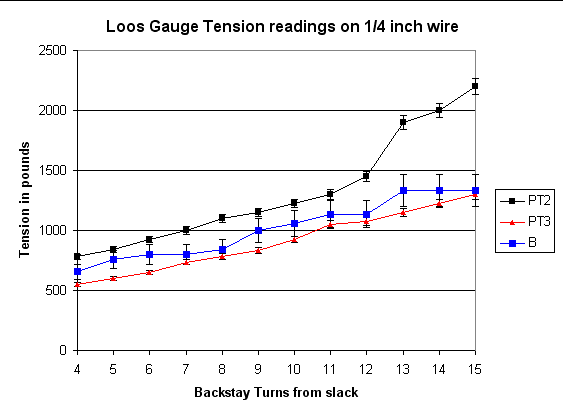
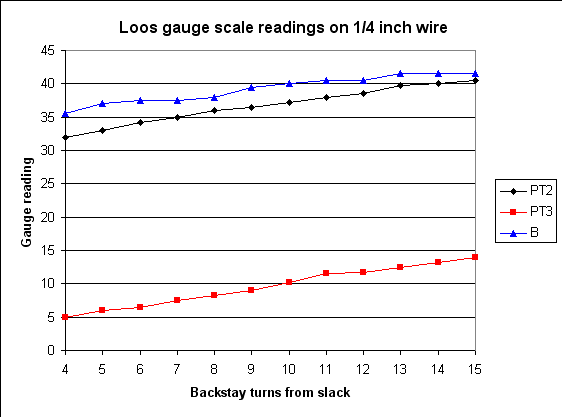
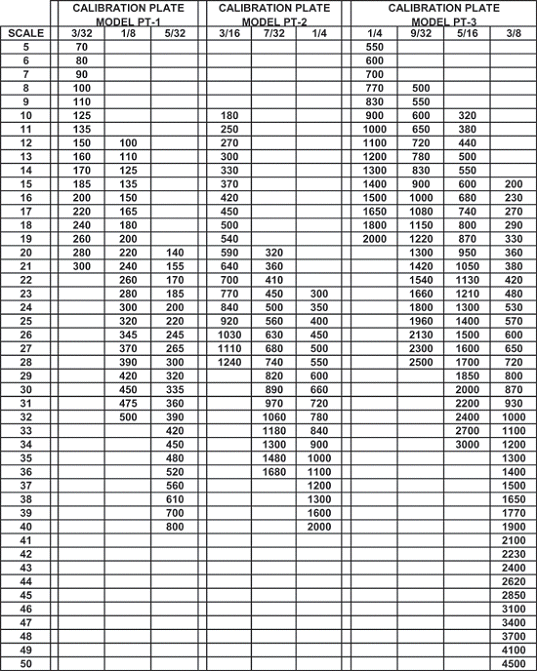
If you would like to look for errors in what I did, here is the spreadsheet: CLICK for XLS spreadsheet
I have emailed Loos and Company and here is their response:
Our head engineer has reviewed your e-mail & comments with the following:
I do not dispute your findings on the gauges you have. Upon hearing of this
I took from our stock a PT-2 & PT-3, placed them on the 1/4" 1x19 test stand.
The PT-2 read #38=1300# on 1/4"
The PT-3 read 13-1/2 - 14 = 1300# on 1/4"
I do not know the cause of your discrepancy without having the actual instruments.
Thank you
Barry for Loos
Update: I called and talked to Barry and am sending my PT2 back to Loos for calibration. They calibrate at 1300#, which just happens to be my target tension so I think this will solve my problem.
Allen
Another measurement
A line is attached at 53.625 inches off the deck pivot and led a right angles to a pulley on the cabin top and then to a pulley on the bow and attached to a bucket. I put a mark on the line and then add 5 gallons of water and measure the deflection of the wire. At 8.25 pounds per gallon I have 41.25 pounds and I get 2.41 inches of deflection. I am careful to shake the wire around to remove the friction in the system and get everything centered up. This forms two triangles. I take the arc-tangent to get two angles. One is ArcTan(2.41/53.625) = 2.57 degrees and the other is ArcTan(2.41/458)=0.3 degrees. Whatever tension is in the wire will pull on my line with this force T * sin(2.57) + T * sin(0.3) = 41.25. Thus T = 824 pounds. That number is way different than the gauges. This measurement was done with 14 turns on the backstay which corresponds reads 39.5 on my PT2 this same day or 1800 pounds and from my measurements of the PT3, 1225 pounds.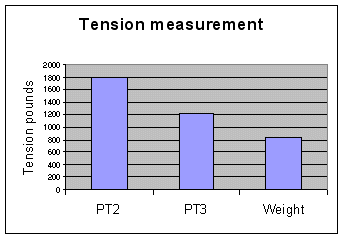
Final Update on gague
Barry at Loos examined my PT-2 and found it to be accurate. He measured all the dimensions and put it on his test wire and found that at 1300 pounds he got a reading of 38, which is dead on. Since I got a reading of 11.5 with the PT-3 when my PT-2 read 38 and that corresponds to 1050 pounds, we can just assume there was something wrong with the brand new PT-3. The Model B read 1210 at that setting which is reasonably close I guess.Many thanks to Barry and Loos for checking my gauge.
Measurement of tension by measuring stretch
It has occurred to me that I can use the property of the wire to measure the load.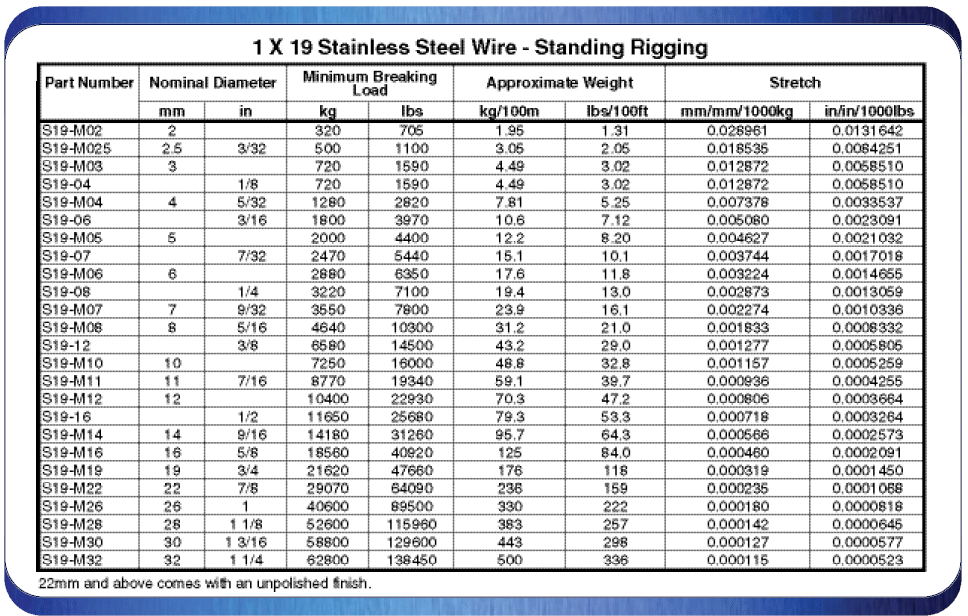
From this table, the stretch of 1/4 inch wire should be .0013 per 1000 pounds. If I stretch the wire from something like 300 pounds to 1300 pounds, 1000 pound difference, I should get 2/3 inch stretch in my 42.7 foot forestay. I do need a way to secure the tape measure at the mast head so that mast compression is not part of the measurement but that should be fairly simple. So, here is what I did.
I took my jib halyard and jammed the rope to wire splice at the masthead and used the wire part as the measure reference as its position at the masthead was fixed. I taped and marked positions on the forestay as I tightened the backstay. The data looks fairly linear so all I need is the starting tension and I can use this measurement to determine the additional tension and by adding these the total tension. I used the PT-2 reading of 425 pounds as the initial reading. If I believe the PT-3, this reading would be 150 pounds less. Here is a graph of the data points and the linear fit line.
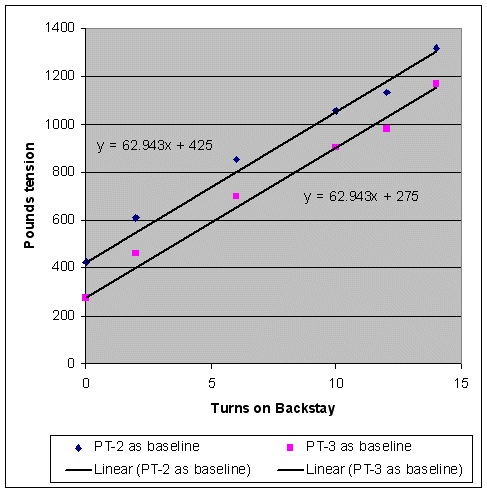
This measurement implies 63 pounds per turn, which is a little less than the 75 I have been assuming. Here is how all the measurements I have taken look at 14 turns.
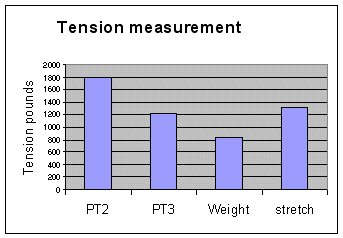
At Last, a direct measurement of tension
Do you think I am a little bit obsessive about this? I built a fixture to make a measurement I could believe. I used a 30 inch piece of angle iron and arranged it so that the end rested on a bathroom scale. 25 inches from there was a hole through which I put the end of a turnbuckle so that I could attach it to the stem fitting. 2.5 inches in front of that was a 1/2 inch hole and a little piece of angle iron that would hold the bottom fitting of the forestay turnbuckle. I installed this and now I had a 10:1 transfer of the load on the forestay to the scale. Well, almost. The forestay was going up at 22 degrees and the scale was at 5 degrees. The difference was 17 degrees and the cosign of this is .956 so this is a correction factor. Because the scale is not aligned with the forestay, it will read a lower force than what is on the forestay. I made measurements every backstay turn from "resting in ths slip" to 16 turns.The results show that the force is linear with backstay turns. This is what theory would predict and contradicts what the PT-2 reads. That was one thing I wanted to find out. There is a non-linearity with the PT-2 readings vs backstay turns so I am guessing they just over did the correction for this. Next, the PT-2 and my test fixture agreed very well at low tension settings. I measured about 58 pounds per turn with this method where the previous measurement using the stretch numbers for the wire measured 63 pounds per turn. That is an 8% difference, which is probably pretty close considering the stretch number had a precision of about 8% (1/13).
The comparisons at 14 turns is in this graph:

You will notice in the above graph there is a bar for 1.5*backstay tension. I took pictures of my boat and calculated the ratio of backstay to forestay tension and it should be 1.5x. I did not get this ratio with the PT-2 and that is what started all this.
Here is the data showing how linear this measurement is compared to the PT-2 measurement.
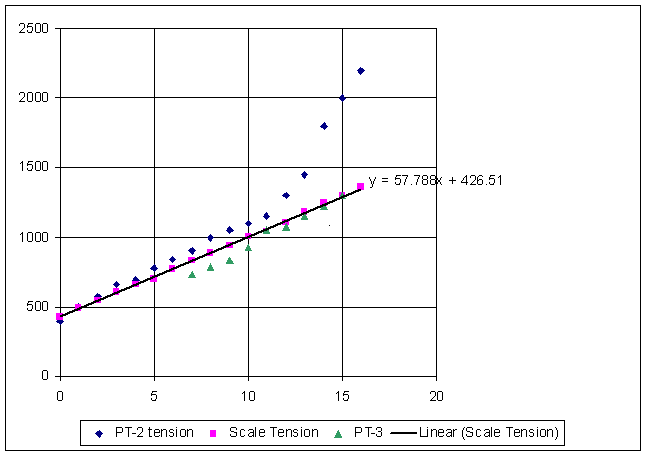
So, why do I get different readings then Loos? Perhaps it is because I use 316 wire and they use 304. I can offer no other explination.
Allen
NOTICE: Some pages have affiliate links to Amazon. As an Amazon Associate, I earn from qualifying purchases. Please read website Cookie, Privacy, and Disclamers by clicking HERE. To contact me click HERE. For my YouTube page click HERE